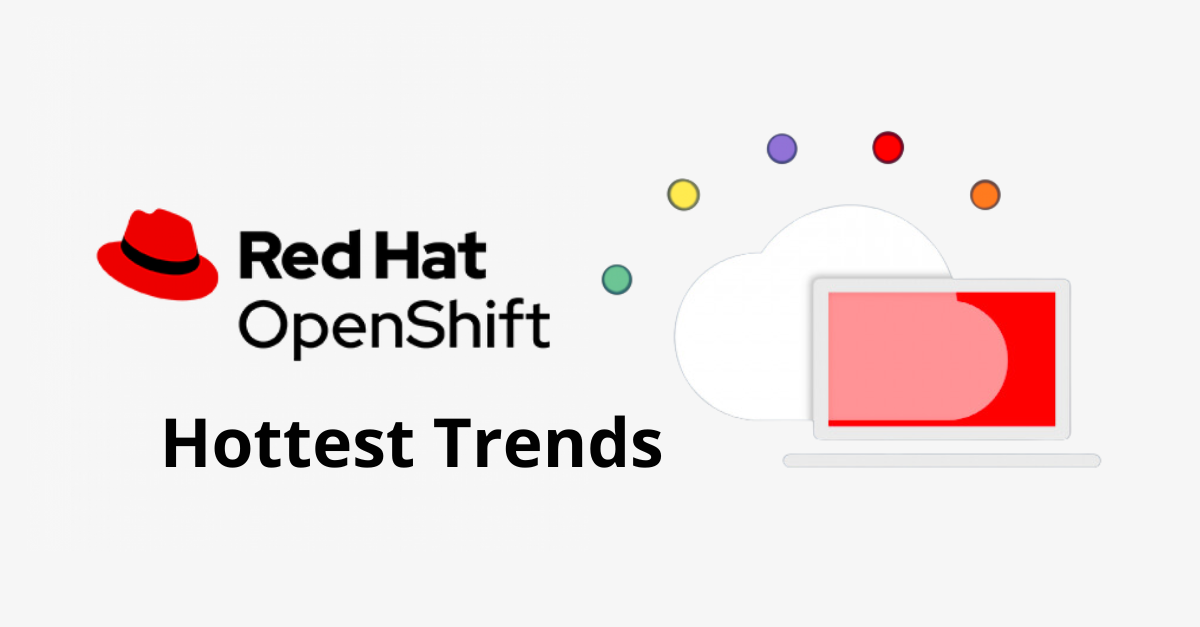Red Hat’s Hottest Trends in OpenShift 2023

In this post, we delve into the top features that have positioned OpenShift as an industry game-changer in 2023.
Welcome to the hottest trends in OpenShift! In today’s lightning-paced digital landscape, organisations are forever looking for cutting-edge solutions to revolutionise their software development and deployment practices.
Enter Red Hat OpenShift, the trailblazing container platform reshaping how applications are built, deployed, and managed.
So, what is OpenShift?
Sometimes called OCP for short, Red Hat OpenShift Container Platform is its full name. Check out our previous blog post for an in-depth guide on everything OpenShift – What is Red Hat OpenShift?. In short, Red Hat OpenShift is a platform designed for building, scaling, and deploying applications in a cloud environment based on Kubernetes, an open-source container orchestration platform.
Top 5 Trends in OpenShift 2023
1. Enhanced Security and Compliance:
Across the cybersecurity landscape, robust security measures are crucial. It is no surprise that security remains the top IT funding priority across all regions and almost all industries. Specifically, network security (40%) and cloud security (38%) were the top priorities. (source.)
OpenShift provides a range of security features, including built-in image scanning, role-based access control, and secure container runtime. Additionally, the platform assists organisations in adhering to compliance standards such as PCI-DSS, HIPAA, and GDPR, helping them meet regulatory requirements and maintain data integrity.
2. Serverless Computing:
Serverless container technologies continue to grow in popularity across all major public clouds, reducing the need to provision and manage underlying infrastructure. One of the standout features of OpenShift is its support for serverless computing. With serverless, developers can focus solely on writing code without the need to manage the underlying infrastructure. This approach enables automatic scaling and efficient resource allocation, leading to cost savings and improved application performance.
3. Hybrid and Multi-cloud Deployments:
As organisations embrace the hybrid and multi-cloud approach, OpenShift offers a seamless solution for deploying and managing applications across diverse environments. Its extensive compatibility with popular cloud providers, including AWS, Azure, and Google Cloud, ensures portability and flexibility. It is easy for developers to build once and deploy anywhere, maximising their reach and minimising vendor lock-in.
4. DevOps Integration:
OpenShift facilitates collaboration and streamlining the DevOps workflow. By integrating with popular CI/CD tools such as Argo CD, Jenkins, GitLab, and Tekton, OpenShift enables organisations to implement efficient automated pipelines, ensuring faster and more reliable application delivery. The built-in monitoring and logging capabilities also enhance observability, allowing teams to address issues and optimise performance.
5. AI / Machine learning:
Machine learning and OpenShift converge to provide a comprehensive platform for developing, deploying, and managing AI and machine learning applications and models. OpenShift streamlines development with a collaborative and containerised environment. Deployment becomes simplified through automation and container orchestration. Scalability and elasticity optimise resource utilisation. Monitoring tools ensure reliable performance. The hybrid and multi-cloud support of OpenShift promotes flexibility. Together, they accelerate development, improve scalability, and manage AI/ML workflows efficiently.
Conclusion:
Red Hat OpenShift continues to dominate the container platform market, offering cutting-edge features that empower organisations to stay ahead in their digital transformation journeys. With its Kubernetes-native architecture, serverless computing capabilities, support for hybrid and multi-cloud deployments, seamless DevOps integration, and robust security measures, OpenShift provides a comprehensive solution for modern application development and deployment needs.
As we venture further into 2023, OpenShift remains a top choice for businesses striving for innovation, efficiency, and scalability.
We hope you enjoyed exploring the hottest trends in Red Hat OpenShift with us. If you would like to utilise these benefits, talk to our team of experts – we would be happy to help!
Tier 2: OpenShift Specialists
Tier 2 are recognised technology leaders and trusted advisers on the OpenShift platform. We are one of a handful of Red Hat Premier Partners to earn Container Platform Specialist status, recognising our position as a technology leader, Red Hat expert, and trusted advisor working with the leading Container Platform in the market. Combined with our Premier Middleware status, this award cements our position as the Red Hat partner of choice for cloud-native development delivery, applications and integration services.
How can Tier 2 help with OpenShift?
Tier 2 provides a team of OpenShift Consultants with accredited Red Hat OpenShift Container Platform skills to help organisations exploit containers, and agile and DevOps processes, to modernise their applications, develop new cloud-native applications, and accelerate application delivery.
We can help with:
- Design, installation and configuration of your OpenShift environment
- Onboarding for OpenShift Dedicated customers
- Set-up of CI/CD pipelines
- Application modernisation to benefit from containers and cloud-native architectures
Looking to implement a container cluster? Talk to a Red Hat Container Platform Specialist. Get in touch.



